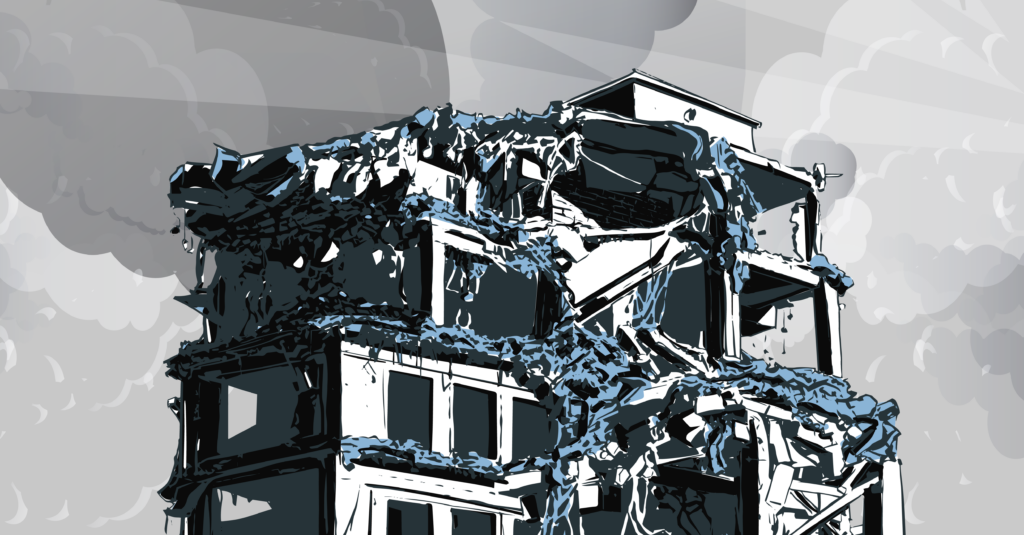How EHS Software and Root Cause Analysis Can Stop Disasters Like the Beirut Explosion
December 3, 2020

On August 4, 2020, just about 6:00 pm, a fire that had been burning at a warehouse at the port of Beirut turned into a cataclysmic explosion that devastated the city, killing more than 200 people and injuring approximately 6,500. According to a team of researchers from Sheffield University, the blast – which caused at least 15 billion dollars in damage and devastated the Lebanese economy – is one of the largest non-nuclear explosions ever recorded.
The fundamental root cause of the explosion was the accidental detonation of 2,750 tons of ammonium nitrate, a chemical compound used in fertilizer production that was stored in the warehouse. However, this explanation neglects the complex interaction of events that led to both the fire and the subsequent explosion.
The Investigation
In November 2020, Legal Action Worldwide (LAW), a non-profit organization that provides access to legal resources for victims of disaster and violence around the world, published a request on behalf of victims for a transparent investigation into the cause of the explosion. The Egyptian newspaper Mada Masr invited Forensic Architecture (FA), a research agency at Goldsmiths, University of London that uses digital modelling and architectural analysis to investigate disasters and human right violations, to examine public evidence and footage as part of an unofficial investigation into the explosion at the port of Beirut.
FA began by analyzing images of the fire uploaded to social media while it was in progress. The first image was uploaded at 5:54 pm and showed the first smoke plume at the northeast corner of the warehouse. FA used the shape of the plume to timestamp additional images from other sources that weren’t time stamped and create a synchronized timeline of the fire from multiple angles. Another video starting at 5:58 pm showed the smoke grow thicker and darken in color at 6:00 pm, suggesting that a new material was burning inside the warehouse.
At 6:07 pm, a new ignition appeared on the northwest side of the warehouse. This produced a larger plume, as well as sparks that suggest the presence of explosive material. The explosion occurred at 6:08 pm, soon after the new source of ignition was spotted. The explosion produced a single spherical plume, suggesting that it came from a single source at a specific location within the warehouse. The resulting red smoke plume rose approximately 755 meters into the air. FA used this moment to synchronize footage of the explosion from additional sources to produce an analysis of the explosion from multiple perspectives.
The different smoke plumes therefore help to suggest the composition of the material burning during the timeframe, where that material was located, the order in which it burned before the final explosion, and the material that finally exploded.
Storage of Ammonium Nitrate
The ammonium nitrate was first brought to the warehouse in October 2014. Shortly after, port officials began warning authorities of the danger of storing such a large amount of potentially explosive material. Some warnings included reports that at least 70% of the bags in which the material was stored had ripped open, with the contents spilling out and becoming darker in color, suggesting it had become contaminated and, therefore, presented a greater danger for combustion.
Earlier videos of the warehouse allowed FA to determine the precise location of 243 bags of ammonium nitrate near the center of the warehouse, and to extrapolate that the remaining 2,507 bags were stored in the 2,000m2 of space directly in the center. Additional material being stored in the warehouse included:
- 23 tons of fireworks
- 50 tons of ammonium phosphate
- 5 tons of tea and coffee
- 5 rolls of slow burning detonating cord, and
- 1000 car tires.
There is a considerable amount of international guidance on the handling and storage of ammonium nitrate. The Health and Safety Executive (HSE) standard states that the risk of an explosion involving ammonium nitrate is increased by heat, contamination, and confinement, all of which were present in the warehouse. HSE also states that the risk of detonation increases when ammonium nitrate is stacked, and therefore suggests a limit of 300 tons to any stacked material. In the United States, the Occupational Safety and Health Administration’s Guidance on the Ammonium Nitrate Storage Requirements in 29 CFR 1910.109(i) state that no more than 2,500 tons of ammonium nitrate can be stored in facilities without adequate ventilation and sprinkler systems. In Canada, the Ammonium Nitrate Storage Facilities Regulations state that no storage facility can store more than 200 tons of ammonium nitrate unless the facility has been constructed exclusively for the purpose of storing hazardous material. All these standards prohibit storing explosive devices like fireworks in the same facility as ammonium nitrate.
Each standard also provides guidance on the safe distance at which ammonium nitrate can be stored from residential areas. The Australian government’s Code of Practice: Safe Storage of Solid Ammonium Nitrate, for example, states that ammonium nitrate must be stored at least 890 meters away from residential buildings per 500,000 kg. FA used this to calculate the safe distance of 1,570 meters as that at which the material in the warehouse should have been stored from the residential buildings in the city. As FA demonstrated, the most significant damage to the city occurred within 1,500 meters of the explosion, meaning that if international guidance had been followed, the death toll and destruction from the blast would have been minimal.
The Findings
According to FA’s investigation, the arrangement and poor condition of the materials in the warehouse, as well as long-term bureaucratic neglect and ignorance, meant that it was essentially a makeshift bomb simply waiting for a catalyst.
FA’s timeline of the disaster is as follows:
| Time | Location | Smoke Plume | Material |
| 5:54 pm | Northeast | Light | Various unidentified materials |
| 6:00 pm | Northeast | Dark | Tires |
| 6:07 pm | Northwest | Light with sparks | Fireworks |
| 6:08 pm | Center of warehouse | Red | Ammonium nitrate |
While the initial cause of the fire has not yet been identified, FA’s investigation makes it clear that the fire started with various unidentified materials, progressed to the tires and fireworks and then finally ignited the ammonium nitrate in the center of the warehouse.
The Lessons
These insights into the explosion at the port of Beirut can teach us about more than simply best practices for storing ammonium nitrate. Instead, we can see that the disaster was the result of systemic failures on the part of the Lebanese government and the Beirut port authorities. By intentionally failing to follow international guidance on storing ammonium nitrate, including storing it too close to residential areas, allowing the material to become contaminated, storage it in quantities that exceeded every standard recommendation, storing it in close proximity to explosive material and ignoring the advice of experts who raised the alarm of the potential disaster, authorities essentially guaranteed that this would happen eventually. Normalcy bias, in which people minimize the potential for disaster even when confronted by direct evidence of its inevitability, is a powerful influence that can inhibit effective decision making and situational awareness, as was very much in evidence here.
There are important lessons here as well for the approach to root cause analysis. While the storage of the ammonium nitrate is certainly the cause of the explosion, the poor culture of safety that contributed to it over the course of several years is vital to understanding the systemic nature of the disaster. Like the Deepwater Horizon and the Space Shuttle disasters, the Beirut explosion is an important lesson in how root causes can be found not only in single events or situations, but in smaller elements that interact over time and aggregate into disaster.
The Importance of EHS Software to Prevent Disasters Like the Beirut Explosion
The tragic explosion in Beirut serves as a reminder of the importance of comprehensive safety management systems. The disaster, caused by the improper storage of hazardous materials, illustrates how systemic failures and a lack of oversight can have catastrophic consequences. Poor safety practices and missed regulatory requirements can lead to loss of life, environmental damage and economic devastation.
With EHS software, organizations can prevent such incidents by automating the tracking of hazardous materials, ensuring compliance with safety standards and providing real-time data to make informed decisions. EHS solutions also offer visibility into potential risks, enabling swift action to mitigate them before they escalate into tragedies.







